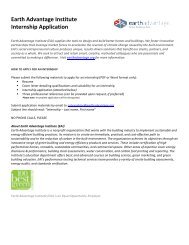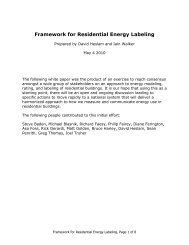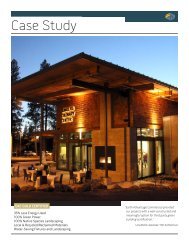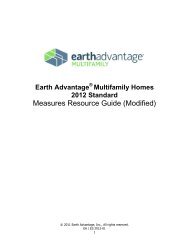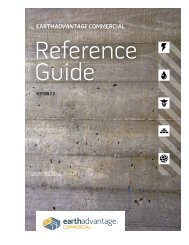EA New Homes Measures Guide - Earth Advantage
EA New Homes Measures Guide - Earth Advantage
EA New Homes Measures Guide - Earth Advantage
Create successful ePaper yourself
Turn your PDF publications into a flip-book with our unique Google optimized e-Paper software.
2012 <strong>Earth</strong> <strong>Advantage</strong> Residential<br />
<strong>Measures</strong> Resource <strong>Guide</strong><br />
8.2.1<br />
Low-Volume Irrigation System<br />
Accountability Form: Landscape<br />
Energy<br />
Health<br />
Materials<br />
Water<br />
0 0 0 0 2<br />
Description: Install a low-volume irrigation that slowly applies water to a plant's root zone. It is a form of micro-irrigation that includes drip<br />
and low volume irrigation systems.<br />
Land<br />
Benefit: Up to 50 percent of municipal water use in the summer is for outdoor irrigation. That's also when rainfall is scarce and reservoirs,<br />
lakes, and streams are at their lowest levels. Low-volume irrigation systems can use 75 percent less water than sprinkler systems during<br />
the time of year that water supplies are lowest. Second, reducing water demand lowers the energy and environmental impacts associated<br />
with collection, transportation, and treatment needed to deliver water for outdoor irrigation use. Third, installing a low-volume system<br />
requires the thoughtful use of drought-tolerant and low-water plants appropriate to your site. Appropriate plants have a higher success rate<br />
and generally require fewer fertilizers and other artificial aids to establish themselves. This reduces the environmental consequences of<br />
fertilizer runoff, as well as the embodied energy to manufacture, transport, and dispose of the fertilizers themselves. Finally, installing a<br />
low-volume system saves money on the water bill.<br />
Low-volume irrigation is more effective at meeting the plants watering needs. There are water savings for the homeowner over the lifetime<br />
of occupancy, and reduced peak summer demand provides savings for the municipality. Low-volume systems are adaptable to the<br />
landscape and can be easily removed when irrigation is no longer required.<br />
<br />
Better systems will have higher up-front cost, but will be offset by reducing water usage. Planning and design are needed to determine<br />
system requirements including performance, minimum efficiency standards, and controller features. As with any irrigation system, regular<br />
monitoring is required to ensure proper operation.<br />
<br />
One negative aspect applies to all types of irrigation, tubing for low-volume systems is often made from polyvinyl chloride (PVC), which is a<br />
significant source of toxins during manufacture and disposal. If possible, select alternatives to PVC such as polyethylene.<br />
Installation should be performed by a certified irrigation specialist and conform to local water use ordinances.<br />
<br />
The average established shrub zone needs approximately 9,300 gallons per 1000 sq. feet each growing (peak) season. Low-volume<br />
irrigation has proven to save 60 percent to 70 percent water over the course of the season with no affect on plant health due to efficient<br />
saturation of the root zone. This is a possible savings of 5,000 - 6,000 gallons per 1000 sq. feet of shrub area installed with low-volume<br />
irrigation.<br />
Verification: <strong>EA</strong> Rater will recognize a low-volume irrigation system by operating the system. System to be operated by technician to verify<br />
no overspray.<br />
8.2.2<br />
Hydro Zoning: Grouping of plants and lawn for watering<br />
Accountability Form: Landscape<br />
Energy<br />
Materials<br />
Water<br />
0 0 0 0 1<br />
Description: Establish separate watering zones for lawn and other plants. Each zone is designed to deliver the appropriate amount of water<br />
to each plant type. This includes selecting proper water delivery methods, such as sprinkler heads or drip emitters.<br />
Health<br />
Land<br />
Benefit: An irrigation system that has been zoned to provide separate watering patterns for shrubs and lawn will use less water than nonzoned<br />
systems. Because lawn requires more water to survive, the over watering of plants will occur if separate systems are not installed. A<br />
study in Eugene, Oregon, showed that a typical lawn needs 18,600 gallons per 1000 sq. feet each growing (peak) season. Analysis<br />
indicates that established shrubs need 50 percent of the water that lawns need. This is a potential savings of 9,300 gallons for each 1000<br />
sq. feet of shrub plantings.<br />
Verification: <strong>EA</strong> Rater will confirm that plants and turf are grouped into similar water needs for each irrigation zone by turning on the<br />
irrigation system to confirm that the system delivers water to each planting zone.<br />
Page 59 of 70



